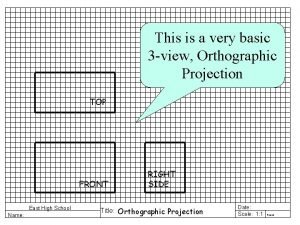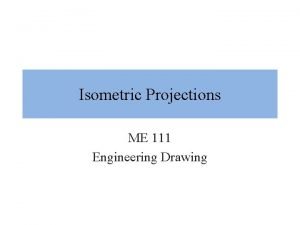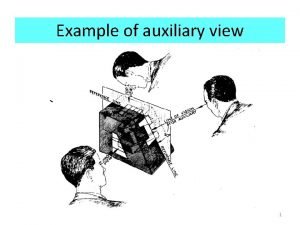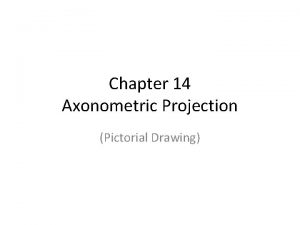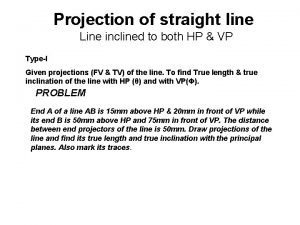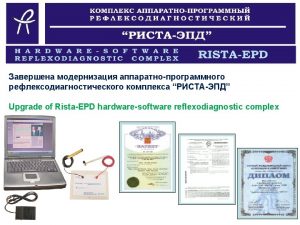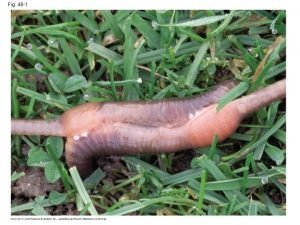Fig 1 Schematic view of the Photoemission top

















- Slides: 17

Fig. 1. Schematic view of the Photoemission (top) and Inverse Photoemission (bottom) processes. Fig. 2. PES and IPES spectra of polycrystalline silver, plotted with a common Fermi level (at E=0). Together they probe the density of states (DOS).

Fig. 3. ‘Universal curve’ of the photoelectron elastic mean free path as a function of kinetic energy. Fig. 4. An impossible ‘vertical transition’ for a free electron (left), and transitions involving reciprocal lattice vectors in a periodic potential.

Fig. 5. Escape conditions for a ‘hot’ electron at the sample surface. Only the component of the electron momentum along the surface is conserved. The electron is refracted. Fig. 6. An ARPES experiment on a metal. The energy of the ARPES peak changes with the emission angle (with parallel momentum), reproducing the dispersion of the underlying band.

Fig. 7. ARPES spectra of the quasi-1 D compound (Nb. Se 4)3 I along the 1 D direction. The band dispersion is well visible in the intensity map. Fig. 8. ARPES intensity map of La. Ru 2 Si 2 measured at E=EF, compared with a theoretical Fermi surface. From Ref. 6.

Fig. 9. Artist’s view of an ARPES spectrum in the opposite sudden and adiabatic limits. The ‘ 0’ transition corresponds to the ground state of the (N -1)-electron system. Fig. 10. Artist’s view of the k-dependent ARPES spectral function is the free-electron limit (left) and in an interacting system (right). (adapted from M. Meinders; Ph. D Thesis, Groningen (1994)).

Fig. 11. Theoretical (line) and experimental dispersion of the conduction band of sodium. The band narrowing is a typical consequence of electronic correlations. From Ref. 10. Fig. 12. Cuts of the ARPES intensity map produce Energy distribution curves (EDCs, at constant k) or Momentum distribution curves (MDCs, at constant energy).

Fig. 13. Normal emission spectra from quantum well states in epitaxial Ag(100) films of varying thickness. From Ref. 12. Fig. 14. ARPES Fermi liquid lineshapes in the 2 D metal Ti. Te 2. Notice the typical FL tail beyond k. F. From Ref. 13.

b) Fig. 15. QP spectra of Ti. Te 2 measured at the Fermi surface at various temperatures. The temperature-dependent linewidth reflects the increasing electron-phonon scattering at high T. (adapted from Ref. 14). Fig. 16. Experimental and theoretical ARPES spectra of a surface state on Be(0001), showing the effect of a strong electron-phonon interaction. The renormalized dispersion is shown in b). From Ref. 15.

Fig. 17. Expected dispersion and DOS(top) in a SC or CDW state, within a mean-field scenario. Fig. 18. (left) Gap opening in the SC cuprate Bi 2212. (right) Evolution of the SC gap as a function of doping in Bi-2212. From Ref. 21.

Fig. 19. Angular dependence of the SC gap in Bi 2212 extracted from ARPES data. The dependence is consistent with a ‘d-wave’ scenario. From Ref. 22. Fig. 20. PES spectra of V 3 Si above and below the SC transition. The lines are BCS fits. Notice the small ‘hump’ above EF, from thermally populated states above the gap. (inset) T-dependence of ∆(T). From Ref. 23.

Fig. 22. Temperature-dependent spectra of a gold reference and of the ‘Kondo insulator’ Ce. Rh. As illustrate the opening of a pseudogap at EF in the latter. The spectra were divided by the Fermi distribution. From Ref. 24. Fig. 21. Temperature-dependent raw (left) and symmetrized spectra of a C 60 monolayer on the Ag(100) surface, showing the opening of a gap at EF. From Ref. 25.

Fig. 23. ARPES Fermi surface map of the 2 D CDW material 2 H-Nb. Se 2. The arrow shows a possible nesting vector. From Ref. 27. Fig. 24. (left) ARPES intensity map of the 2 D CDW system 2 H-Ta. Se 2 along the K direction. (right) Spectra measured at the 2 FS crossings, above and below TP. A gap opens only at k. F 2. From Ref. 28.

Fig. 25. Very high resolution spectra of 2 H-Nb. Se 2, measured on two different FS sheets across the SC transition (TSC=7. 2 K). From Ref. 29. Fig. 26. ARPES intensity map of 1 T-Ta. S 2 in the metallic (left) and insulating (center) phase. The opening of a Mott-Hubbard gap is also evident from the spectra (right). From Ref. 30.

Fig. 27. (left) ARPES intensity map for the organic 1 D compound TTF-TCNQ. (right) The spectrum at k=k. F exhibits a deep pseudogap. From Ref. 31. Fig. 28. Calculated spectral function of the Luttinger Liquid, showing separate spinon and holon excitations. From Ref. 33.

Fig. 29. Experimental valence band dispersion in 1 D Sr. Cu. O 2 and in a 2 D cuprate (right). The broader 1 D dispersion is compatible with spin-charge separation in 1 D. From Ref. 35. Fig. 30. RESPES spectra of the Kondo system Ce. Pd 3 measured across the Ce 4 d absorption edge. (inset) Photon energy dependence of the 4 f signal. From Ref. 36.

Fig. 31. Decomposition into triplet and singlet components of the spectrum of the SC compound Bi-2212. Spinresolved data were taken at the Cu 2 p-3 d resonance. From Ref. 38. Fig. 32. RESPES spectra of the Kondo system Ce. Ru 2 Si 2 measured at the Ce 3 d and Ce 4 d edges, with different surface sensitivity. From Ref. 39.

Fig. 33. Spectra of the 3 d core levels of metallic samarium, at 3 different photon energies. The Sm 2+ surface component is drastically reduced in the bulksensitive high energy spectrum. From Ref. 41. Fig. 34. Band mapping at the Cu(100) surface with high energy photons (h ������� . (courtesy of C. Dallera)
 Fig 2
Fig 2 The top view is directly above the right side view
The top view is directly above the right side view Front view top view
Front view top view How to draw cylinder
How to draw cylinder Schematic view of swapping
Schematic view of swapping Swapping chapter 6
Swapping chapter 6 Schematic view of swapping
Schematic view of swapping Martens schematic theory
Martens schematic theory Schematic view of virtual file system
Schematic view of virtual file system Schematic view of swapping
Schematic view of swapping Types of auxiliary planes
Types of auxiliary planes Views
Views The front view of a line inclined at 30°
The front view of a line inclined at 30° Pictorial projection
Pictorial projection Draw the projection of a 75mm long straight line
Draw the projection of a 75mm long straight line Top level view of computer components
Top level view of computer components Orthographic projection elevation
Orthographic projection elevation Bus interconnection scheme diagram
Bus interconnection scheme diagram

